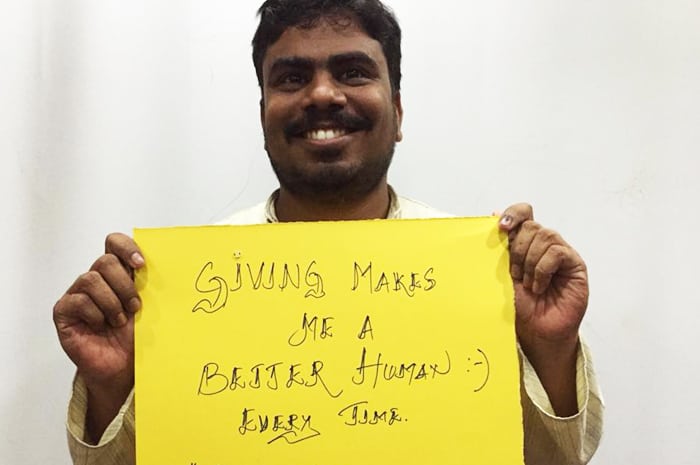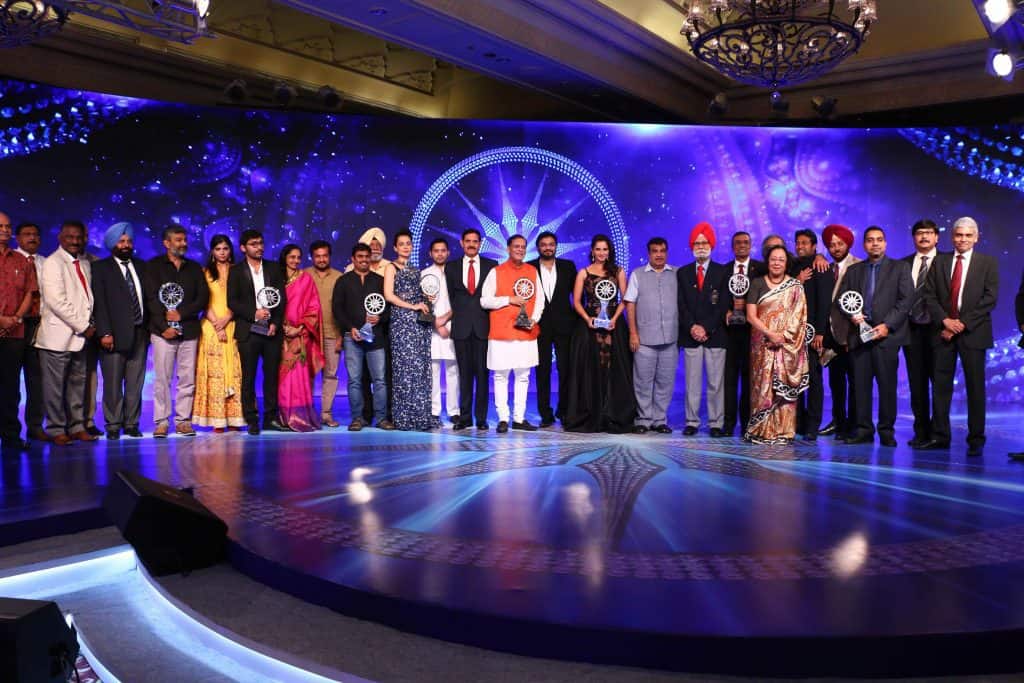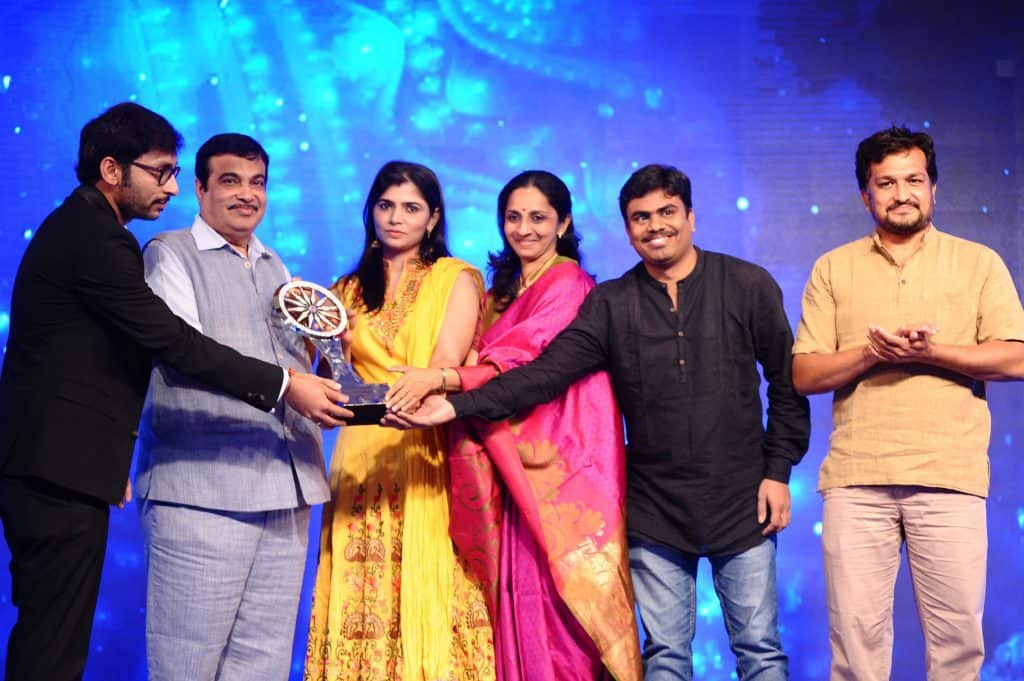The real heroes of the 2015 Chennai floods: A volunteer reflects
It’s been a little over six months since Chennai found itself in the grip of ravaging floods that wreaked havoc in the urban landscape and devastated its people. But it was again the people who helped the city get back on its feet and tales of heroic volunteerism during those days of crisis abound. Selva Ganapathy, one such volunteer from AID India, recently accepted the CNN-News 18 “Indian of the Year 2015” award on behalf of the ‘People of Chennai’ for their public service during the city floods. Here, he recounts his experiences of those frightful days and receiving national recognition on behalf of all his fellow citizens.
 It was in mid of November 2015 that we decided to start collecting relief material for distribution as many low-lying areas, particularly in the sub-urban part of the city, were inundated and the waterlogging was affecting the daily routine of the people in those areas. A group of organizations including AID India, Sri Arunodhayam Charitable Trust, Arappor Iyakkam , Bhumi, Bhoomika Foundation, Banyan, Chennai Volunteers and Udhavum Ullangal along with a few more individuals came together to form Chennai Rain Relief.
It was in mid of November 2015 that we decided to start collecting relief material for distribution as many low-lying areas, particularly in the sub-urban part of the city, were inundated and the waterlogging was affecting the daily routine of the people in those areas. A group of organizations including AID India, Sri Arunodhayam Charitable Trust, Arappor Iyakkam , Bhumi, Bhoomika Foundation, Banyan, Chennai Volunteers and Udhavum Ullangal along with a few more individuals came together to form Chennai Rain Relief.
We were collecting mostly dry rations and were distributing these through our partner network. Some were also distributing cooked meals to a large number of people. The Hindu had just noticed our work and published an advertisement about how people could pitch in with our group.
On November 23rd, I was in Hyderabad in the morning and by the time I came back to the city that night, there had been another heavy downpour bringing the city to a standstill. I learned that many places had got waterlogged during the peak traffic hours and the city traffic was completely haywire with water up to a couple of feet on all major roads.
In fact I was unable to find any mode of transport — taxi, auto or bus — from the airport to the city. The taxis who were ready to come were asking for anything between Rs 2000 and 3000. I thought to myself that even if I paid that amount, and then got stuck in water, it would be futile and hence I decided to stay up there at the airport; I came to office the next morning. By then, the waters had receded.
In the newspapers, I read that the drain lines had been cleared just a couple of days earlier, which helped the water recede faster. So I was happy that we had a system in place that was able to handle such volumes of water and could get it to recede within a few hours only.
Our distribution work continued as many low lying areas had been affected worse after this rain. A week later, I was thinking of when to stop this process of collecting and distributing and planned to call others to check their opinion on the same.
That was another normal rainy day when I came to work on December 1st, but the downpour that day seemed to get worse over the day and it really got me worried. I started to hear from many places about the water levels increasing again and power was already out at several places. I wanted to avoid getting out immediately after office hours so as to avoid the traffic on the roads, but by 6.30 pm, we had a power cut on the IIT campus as well.
Thankfully, I had been thoughtful enough to charge my mobile fully before that and due to the incessant rain, I decided not to step out of office and spend the night in the lab. From 9.30 pm onwards I started to receive calls and Whatsapp messages from many places of the city and also from concerned parents in other states, asking about the whereabouts of their children. I was able to answer everyone and requested them to stay calm. At that time, I was unaware about the floods which had come from the Chembarapakkam lake.
I kept answering calls the entire night and was eventually losing the signal on my phone. I figured out that it must be because of the mobile tower losing electricity. I then moved to my car and started to charge my phone through an USB and drove around within the campus where my phone could catch the signal and started to attend calls from people.
Next morning, I was sure the bridges would have water flowing over them and hence wanted to avoid taking my car out. I went to Madhya Kailash, took a train to reach Mylapore and walked in hip-deep water to reach Royapettah where we had power and signal on phone. We set up a control room there, and from there we helped people and the Corporation with rescue work.
We also filtered most of the requests which came to us after verifying genuine needs, so that we had a comprehensive list of people who wanted help and also people who were ready to offer help. We took turns to sleep in the control room. The previous night was the scariest night of my life.
By now, all our staff from AID India had gathered in the office and started planning how to reach out best to people. We initially chose three areas where we would distribute materials. I joined the team in office and made sure that I was always available on phone/Whatsapp and reachable via mail/Facebook. I remember one morning when I had to stand on top of a pillar in the third floor of our office, talking to people because that was the only place in the office where my phone could connect to the network.
I had not spoken to my family for around a week now, as they were residing at my cousin’s place. My sister had a one-month old baby. It did bother me a little that I had no means to connect to them, but I assumed that they would be safe.
AID India’s work soon reached beyond the initial three areas, reaching more than 45 areas in Chennai. We were sending a constant supply of materials to Cuddalore, Kancheepuram and Thiruvallur districts. The organizations of the Chennai Rain Relief group also reached as many places they could to make sure that people received enough material. The amount of volunteers we got in AID India’s office was something I had never imagined. We had around 400 volunteers dropping by every day on an average. The way people came forward to pitch in, in whatever capacity they could, really moved all of us.
For about 10 days we were completely cut off from Road, Rail, Airport and Harbour connections, but by the end of this period, the city started to get back on its track. Most of the low lying areas were still waterlogged but people started coming back to work. Even people whose houses were affected came forward to work and volunteer, putting aside personal concerns. The entire country actually was in awe when it learnt what Chennai and its people were doing for themselves.
That was our real Pride — standing up for ourselves when needed, showing others the inherent compassion and goodness we possess and setting an example in how to lend a helping hand to each other when needed! It was a troubling fact that the Government had not done its part, but it was a surprise to see most of the officers and bureaucrats coming forward to help citizens. The way the Kotturpuram Police station people contributed during the floods was unimaginable!
Most of our celebrities had also hit the roads, addressing people’s concerns. Ilayaraja himself visited several places in Chennai and also the villages. Siddharth, RJ Balaji, Chinmayi and volunteers of Chennai Micro worked extensively to make sure that they could reach out to as many people as possible.
The Chennai Trekking Club had a team in place ready to rescue people and also worked a lot on mobilizing volunteers who did amazing work in the field. They also continued their good work by cleaning up the river banks after the floods. Kotturpuram was entirely cleaned up by them. We also saw Goonj coming in to help, once the roads and rail lines were open.
It was indeed a crazy, unprecedented and unexpected 30 days of experience between November 15 and December 15 for many of us. We were all looking forward to a new beginning and the dawn of 2016 was indeed a happy new year for many of us! Through AID India, we planned to construct homes for people who had lost huts in villages. We are still in the process and it may take 18 more months.
The Real Impact
The way people see others and life after the floods in Chennai is different from how it used to be. Many small citizen groups have been formed and they are trying to identify local problems and seek solutions to them. Many people have told me that they are now taking additional care of their neighbourhoods. People who didn’t even know their neighbours earlier are now interacting as a community. When a major disaster does this to a city and its people, you have to call it a blessing in disguise!
 Recently CNN-News 18 called me, stating that they would be felicitating some of us who had contributed during the Chennai floods; they invited me to an event on June 9th at Delhi, where they would host my travel and stay. I was thrilled but had absolutely no idea of what the award was all about. Later I browsed their website and got to know that this was the Indian of the Year award where they had nominated the “People of Chennai” in the public service category.
Recently CNN-News 18 called me, stating that they would be felicitating some of us who had contributed during the Chennai floods; they invited me to an event on June 9th at Delhi, where they would host my travel and stay. I was thrilled but had absolutely no idea of what the award was all about. Later I browsed their website and got to know that this was the Indian of the Year award where they had nominated the “People of Chennai” in the public service category.
I knew there were a few more from Chennai who were also invited, but did not know who they were. After reaching Delhi, I got to know the others: RJ Balaji, Chinmayi, Aruna Vishwanathan and Piyush Sethia (of Salem Citizen Forum). Though AID India and Chennai Micro work together, I had never met RJ Balaji and Chinmayi in person earlier. It was a great feeling to meet all these people from Chennai, especially as I’ve always admired them for their hard work and the uniqueness they bring to their respective professions. However, we didn’t have much time to interact in person during the event.
The public service category award was, as expected given to the ‘People of Chennai’; the five of us represented the whole of Chennai and received the award from Union Finance Minister Arun Jaitley. I knew that there must have been many more who would have done a better job than I during the floods, even a few who had lost their lives while volunteering, but it was in fact a matter of great pride for me to represent my city and receive this award on behalf of all its people.
I also learned that Kangana Ranaut, my favourite actress, was there to receive a special achievement award and I was so happy that I would get to see her up close. Throughout the award ceremony, I am not sure what else happened around me but I was looking at her most of the time!
I was also eager to see who would be “The Indian of the Year 2015.” All other categories are based on nominations but The Indian of the Year award is the highest award which the jury decides on. This award had been conferred to our Prime Minister Narendra Modi last year and to the organisation ‘Stop Acid Attacks’ for the year before that. Just as the suspense built itself up to a peak, came the announcement: the ‘People of Chennai’ had been chosen the winner!
For a moment, I could not believe it. I had to pinch myself to make sure that I had not lapsed into a dream world after seeing Kangana! We 5 of us walked up again with pride to tell and show the nation that Everyone from Chennai was The Indian of Year 2015. What a proud moment for a city that stood up when needed!
Moments of pride
Receiving the ward
 The award was given to us by Nitin Gadkari, Minister for Road Transport and Highways and Shipping. All the winners were asked to come together for a group photo and I kept thinking that after the event, I would go to Kangana and request a photo with her. To my utter delight, she was standing next to me in the group photo. I asked her for a photo and she readily agreed, after congratulating us.
The award was given to us by Nitin Gadkari, Minister for Road Transport and Highways and Shipping. All the winners were asked to come together for a group photo and I kept thinking that after the event, I would go to Kangana and request a photo with her. To my utter delight, she was standing next to me in the group photo. I asked her for a photo and she readily agreed, after congratulating us.
Later I also met another icon, SS Rajamouli who won the Indian of the Year in the Entertainment category. I told him that his Baahubali team had shared word of AID India’s relief work on their Facebook and Twitter pages. He is someone who inspires me a lot as a storyteller and I got an opportunity to share this with him.
I also met Army Chief Dalbir Singh and he was all praise for the people of Chennai and for our work during the floods. He mentioned he was at Sri Lanka at the time and had come as soon as he could make it, and was really glad to see so many people pitching in with relief operations on the ground!
I also met a woman Army major who hails from Chennai and who said that she felt very proud that the people of the city had got the award.
In all of this, it has to be reiterated that the award belongs to every single person from Chennai! I hope that the responsibility and humanity which we bestowed upon each other during those days of crisis will continue to guide us and we will not need another disaster to bring that out again!
Selva Ganapathy has been volunteering with AID India for the past ten years, and has mobilized more than 10000 volunteers across the country, raising funds of more than Rupees 1 crore. When he is not volunteering, Selva works as a technical laboratory assistant at IIT Madras. He can be reached in his email: aid.selva[at]gmail.com. He is a real Changemaker!